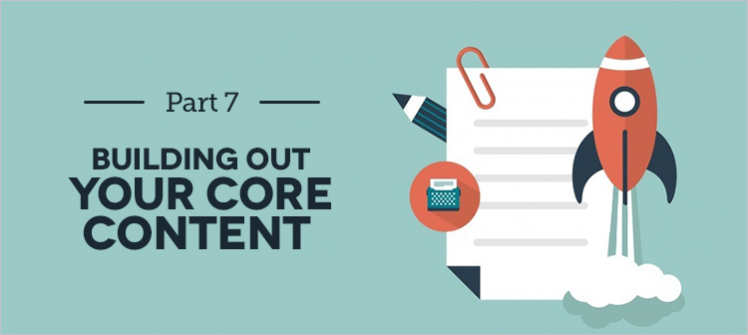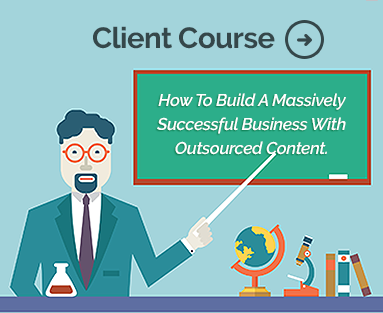I wanted to let you know that the final few chapters are going to be a little different than what we’ve covered so far. From here on out, the lessons will focus on actions to make your website more powerful through content marketing.
Let’s start with a blank slate. Forget about your website for a moment and pretend that it doesn’t even exist. We’re going to start from scratch on how to make your website a conversion machine, and then you can make the required changes later to bring it up to speed.

First, let’s cover a few technical basics that every modern website has to have-
- A responsive design (meaning it displays nicely on phones, tablets and PC’s)
- A modern theme that uses the latest net standards (for optimal load times)
- A simple to use, organized navigation to get users to their destinations quickly
- A simplified layout that’s visually appealing and user-friendly (colors, images, etc.)
If your website does not meet all of those criteria, then you’re either completely outdated or overloaded with plugins that sap your loading times and overall user experience.

That’s not a good thing- especially when you can have someone convert your site to WordPress and install a kick-butt theme at a very affordable price.
Additionally, if your website is not fully responsive then you’re likely missing out on almost 75% of your potential traffic anyway. That’s how many people shop of smartphones and tablets these days. So an upgrade could literally pay for itself within a matter of days or weeks if you generate leads online.
Next, let’s talk about your homepage itself.
Let’s say that I am an ideal customer for your business and we just happen to meet on an elevator one day.
Once you mention what you do for a living and I show some interest, you have exactly fifteen seconds to convince me to try out your store. We’re passing the 6th floor as we speak and you already know I’m getting off on 15…so you have that much time to make a solid impression.
What do you say?
Whatever that message may be, that’s what should be the very first thing customers see on your website- likely summarized in text over your site’s main image.
Remember earlier when we said that the average user takes less than 3 seconds to decide if they like a website or not? That’s why you always lay your best cards on the table right away. This builds confidence in the user and lets them know that they arrived at the right place.
The next step is to guide the user to exactly what they’re looking for…and that should always be within two clicks of your homepage (preferably one). Since users are so visual by nature these days, you don’t want to rely just on your navigation menu to get them to the right place- that’s what the rest of your homepage is for.

For example, take a look at one of my employee’s accounts at Amazon.com. Just at a glance, we can see shortcuts to Keith’s account, his Prime membership and every interaction he’s had with this site in the past…all without scrolling down the homepage. Just look at the information packed in that small space-
- He has four deliveries coming
- He can download a free audiobook
- He can access unlimited photo storage
- He can access all his account info
- He can access his Prime benefits
- He sees an ad for Amazon Dash
- He can list items for sale
- He can buy a gift card
- He can look at personalized deals
- He can shop today’s sales
- He can learn about Amazon Business
- He has three additional ways to shop
- He can donate to the ASPCA charity
- He has a link to receive help
Again, that’s just in the first few inches of the homepage, yet none of it appears forced or overcrowded. That’s why Amazon is one of the biggest retailers in the world today; they completely understand their customers and make it super-easy for visitors to quickly find whatever they need…despite their site having millions of unique pages.
So when we decide what to do with your homepage, we want to do exactly the same thing Amazon does; just on a much smaller scale. That means your homepage should be split into individual sections that address one specific interest your customer has.
For example, let’s re-visit the pet store example from the last chapter. On a pet store’s homepage, we would want-
- A banner(s) showing current specials/promotions
- A section for each major product category
- A small “about us” section (your elevator pitch)
- An area(s) for things like ordering, shipping and store hours
- A sign-up for monthly email notifications
- A CLEAR way to receive immediate assistance
- Multiple areas with contact info (phone, social, etc.)
- A map to your store (if you have a physical location)
- A link to a FAQ page to get immediate answers
- A link to guides and other helpful information
- A feed from the blog page of current topics

If you’re doing the math in your head about how many total pages your website needs to be a complete resource for all customer-types, then you might feel a little intimidated. It’s likely that you’re missing dozens of important pages.
That’s exactly why iWriter is here though- so you can build a complete website at an affordable cost.
Just be sure to start with your most important core pages first AND post contact information at every possible turn. That means putting your info in the header, the footer, on banners and within every single help article your site provides.


 Previous Lesson
Previous Lesson


